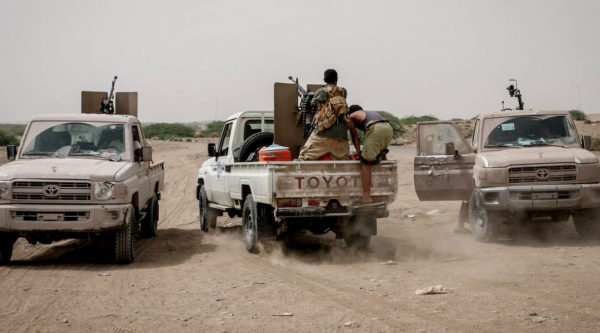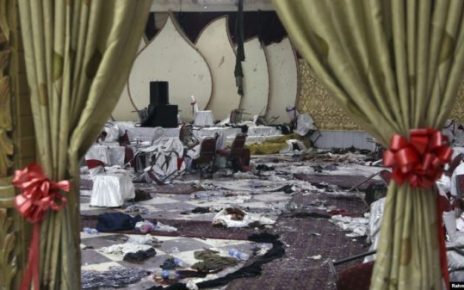The Saudi-led coalition, unable to secure control of the strategic port city of Hodeida, has recently flooded the cities and towns surrounding Hodeida with foreign and indigenous mercenaries, hoping to bring the port city to its knees by taking control of the surrounding region.
Backil al-Shimi is one of the thousands of Yemenis from the Amran governorate that volunteered to join a group of Yemeni civilians fighting alongside Ansar Allah (Houthi) fighters this week. “I am not ready to see my sons die from famine or malnutrition” al-Shimi, a father of eight told MintPress. Hailing from the village of al Shim, 45 km south Sanaa, al-Shimi participated in a fierce battle to retake control of the city of al Jah, 20 km south of Hodeida, after it was taken by Saudi coalition fighters in a recent attack.
The Saudi-led coalition, unable to secure control of the strategic port city of Hodeida, has recently flooded the cities and towns surrounding Hodeida with foreign and indigenous mercenaries, hoping to bring the port city to its knees by taking control of the surrounding region.
Huge numbers of Yemeni residents, sparked by reports of human rights violations, have responded by taking to the battlefield in the largest draw of volunteer fighters since the U.S.-backed Saudi coalition began its offensive on the strategic port of Hodeida three weeks ago. A Houthi military field commander told MinPress that over 5,000 fighters have mobilized in the cities of al Jah and Tuheita, and an additional 3,000 are on standby.
On June 24, volunteer fighters supported by the Houthis expelled Saudi-led coalition fighters, as well as the mercenaries under their employ, from the cities of al Jah and al Fazah, south of Hodeida. Fighters danced in the streets to the sounds of traditional Yemeni music called Zamah and celebrated their victory amidst the rubble of burned out coalition military vehicles.
The retaking of al Jah has effectively cut the supply lines used by the Saudi-led coalition to transfer weapons and reinforcements to Yemen’s western coast and left Saudi and UAE forces in the north surrounded with no outlet save the Red Sea.
The road to al Jah remains challenging. An endless barrage of coalition airstrikes has made driving it extremely difficult and the bodies of Saudi coalition fighters, killed in violent clashes over the past three days, litter the roadway. Most of the coalition fighters killed in the battle were mercenaries from across Yemen according to the identification cards recovered from their bodies, but the bodies of fighters from as far away as Sudan have turned up at local hospitals. A source inside Yemen’s military confirmed that over 1,300 mercenaries, including commanders, have been killed during the past three weeks of heavy fighting on Yemen’s southwest coast.
Sudanese soldiers in Hodeida province. pic.twitter.com/qBRHXM1sYm
— Yemen Observer (@YemeniObserv) June 23, 2018
Reports of human rights violations committed by Saudi-led coalition mercenaries sparked an uproar across Yemen, contributing in large part to the mass mobilization of volunteer fighters to the country’s southwest. Saudi Arabia and its allies have relied heavily upon paid mercenaries and foreign fighters in their war on Yemen, relegating their own troops to carrying out airstrikes, protecting Saudi Arabia’s vulnerable southern border, and commanding the myriad of mercenary forces employed by the coalition.
Amongst the most notorious groups fighting on behalf of the Saudi-led coalition are the Giant’s Brigade and the Tariq Force, both a hodgepodge of indigenous Yemeni groups with ever-shifting alliances and a propensity for extra-judicial killings and looting. The groups share the same Wahhabi ideology as radical Islamist organizations in the region such as al Qaeda in the Arabian Peninsula (AQAP) and the so-called Islamic State (ISIS). Wahhabism is also the extremist branch of Sunni Islam adopted as the official state religion by Saudi Arabia.
In an interview with MintPress News, Ahmed Abdu Zaid, a 50-year-old Brigadier General of the Tariq Forces who would later defect to the Houthis, said he witnessed Saudi coalition mercenaries, “taking over and looting people’s homes and hurling bodies into the sea.” Abdu Zaid, who in the past has appeared on the UAE’s Sky News as a coalition leader, turned himself over to Houthi security forces shortly after speaking with MintPress, saying before he left, “what they were doing is a crime. I couldn’t bear it.”

Abdu Zaid also said that many of the Saudi-led coalition’s purported battlefield victories were either inflated or outright false. “Our victories were fake, like when they said that all but fifty troops in the al Madhai Brigade were killed or when they said that they killed 250 fighters from the Samir al Maskri Brigade, I know what really happened in every one of those battles,” he told MintPress.
Saudi Arabia’s state-run al-Arabiya TV confirmed last Thursday that Saudi-led forces suffered huge casualties after a commander, identified as Abduh Zayd, who was close to the family of slain Yemeni former president Ali Abdullah Saleh, defected to the Houthis in Hodeida.
As has become a trademark for Wahhabi groups in the region, coalition mercenaries have also targeted many of the local historic and religious sites that dot southern Yemen. On the outskirts of the village of Fazah, along the main road near the deep blue waters of the Red Sea, a shrine to the revered Sufi saint, Sheikh Ahmed al-Fazah, the town’s namesake and a figure whose local legend has come to represent world peace, used to draw visitors from around Yemen before it was razed by the Giant’s Brigade. Coalition mercenaries harbor a particular disdain for Sufis, an offshoot of Islam focusing on mysticism and spirituality. In January of 2016, UAE-backed militants destroyed the 800-year-old tomb of Sufi scholar Sufyan bin Abdullah in the southern town of al Hota. Emirati officials claim they have no control over the actions of their surrogate forces.
According to data obtained by MintPress from the Yemen Military Media Department, over 355 coalition armored vehicles have been destroyed since the three-week long southwestern campaign began, much of the equipment destroyed by Yemen’s own Air Force. In late May, Houthi leader, Abdulmalik al Houthi, signaled a shift in strategy – calling on Yemen’s Army as well as the country’s volunteer fighters – to “drain the enemy by targeting armored vehicles with rockets.”
The impending defeat of coalition-aligned forces in the southwest calls into question the future of the Saudi-led campaign in Yemen. Despite some of the highest military expenditures in the world, Saudi Arabia and her allies are unlikely to be able to bear the brunt of heavy losses of equipment, personnel, and perhaps most importantly, morale. Last week thousands of Yemenis staged a mass rally in Yemen’s capital Sanaa, vowing to defend Hodeida’s residents by any means necessary. Hundreds of the demonstrators reportedly left the rally en route to the frontlines.
Source: www.mintpressnews.com




